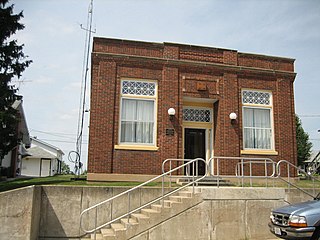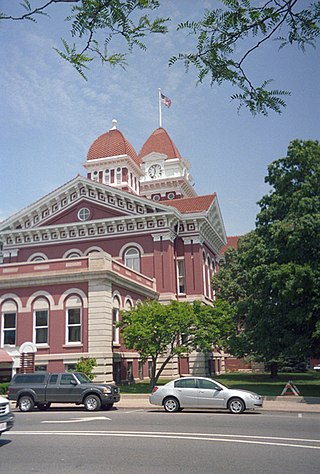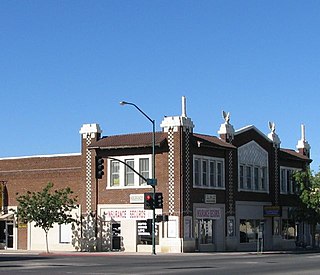
Eufaula is the largest city in Barbour County, Alabama, United States. As of the 2010 census the city's population was 13,137.

Glenville is an unincorporated community in Russell County, Alabama, United States which used to be in Barbour County. During the Civil War, Company "H" of the 15th Regiment Alabama Infantry was raised from Barbour and Dale counties and called the "Glenville Guards". The Glennville Historic District, containing the antebellum core of the community, is a historic district listed on the National Register of Historic Places in 1979.

The People's State Bank building is located in the Stephenson County village of Orangeville, Illinois, United States. The structure was erected in 1926 when two Orangeville banks merged to form the People's State Bank. It operated until 1932 when it became overwhelmed by an economic disaster caused by the Great Depression and the bypassing of downtown Orangeville by an important route. The building is cast in the Commercial style and features Classical Revival detailing, common for banks of the time period. The building was added to the U.S. National Register of Historic Places in 2004.

There are nine historic districts in Meridian, Mississippi. Each of these districts is listed on the National Register of Historic Places. One district, Meridian Downtown Historic District, is a combination of two older districts, Meridian Urban Center Historic District and Union Station Historic District. Many architectural styles are present in the districts, most from the late 19th century and early 20th century, including Queen Anne, Colonial Revival, Italianate, Art Deco, Late Victorian, and Bungalow.

The Warsaw Courthouse Square Historic District is a historic district in Warsaw, Indiana that was listed on the National Register of Historic Places in 1982. Its boundaries were increased in 1993.

Crown Point Courthouse Square Historic District is a historic district in Crown Point, Indiana, that dates back to 1873. It was listed on the National Register of Historic Places in 2004. Its boundaries were changed in 2005, and it was increased in 2007 to include a Moderne architecture building at 208 Main Street. The late nineteenth- and early twentieth-century commercial and public buildings represent a period of economic and political growth. The Lake County Courthouse stands in the center of the district. Designed by architect John C. Cochrane in 1878, this brick building is a combination of Romanesque Revival and Classical styles. Enlarged in 1909 with the addition of north and south wings, designed by Beers and Beers. Continued growth in the county required second enlargement in 1928. This local landmark was placed in the National Register of Historic Places in 1973.

The Carlowville Historic District is a historic district in the community of Carlowville, Alabama. It covers 780 acres (320 ha) and is centered on Alabama State Route 89 and Dallas County roads 4, 47 and 417. It was placed on the National Register of Historic Places on January 18, 1978.

The Downtown Adrian Commercial Historic District is a historic district comprising the downtown area of Adrian, Michigan. It was designated as a Michigan Historic Site and added to the National Register of Historic Places on April 17, 1986. The district is roughly bounded on the north by Toledo Street, on the east by North Broad Street, on the south by East Church Street, and on the west by North Winter Street (M-52), West Maumee Street, and the River Raisin. Most of the district is enclosed by the US-223 Business Route, although the two are not conterminous.

The Downtown Athens Historic District is a historic area in the Downtown Athens neighborhood of Athens, Georgia. It was listed on the National Register of Historic Places in 1978. Its boundaries were revised twice, in 1984 and 2006, and additional documentation was filed in 2006.

The Philippi Historic District (PHD) is national historic district located at Philippi, Barbour County, West Virginia, USA. It encompasses 113 contributing buildings and one contributing structure dating from the mid-19th century through early 20th century. The district includes the commercial, ecclesiastical, and civic core of the town situated along the Tygart Valley River.

Fendall Hall, also known as the Young–Dent Home, is an Italianate-style historic house museum in Eufaula, Alabama. The two-story wood-frame structure, with a symmetrical villa-type floor-plan and crowning cupola, was built between 1856 and 1860 by Edward Brown Young and his wife, Ann Fendall Beall. It remained in the Young family for five generations, passing to the builders’ daughter, Anna Beall Young, and her husband, Stouten Hubert Dent in 1879. It was added to the National Register of Historic Places on July 28, 1970. The Alabama Historical Commission acquired it in 1973 and restored it to an appearance appropriate to a time-frame spanning 1880–1916.

The Wicks Building is a historic commercial building on Courthouse Square in downtown Bloomington, Indiana, United States. Built in the early twentieth century in a distinctive style of architecture, it has remained in consistent commercial use throughout its history, and it has been named a historic site because of the importance of its architecture.

The Highland Park Historic Business District at Euclid and Sixth Avenues is located in the north-central section of Des Moines, Iowa, United States. It is located on the border of the Oak Park and Highland Park neighborhoods. The commercial historic district has been listed on the National Register of Historic Places since 1998. The Highland Park neighborhood also includes the College Corner Commercial Historic Business District.

The Benson Building, also known as the Union Bus Depot, was an historic building located in downtown Ottumwa, Iowa, United States. The Tudor Revival style commercial building was completed in 1930. The one-story structure was composed of highly textured, painted brick. The façade featured a steeply-pitched gable roof and half-timbering. The building was originally used as an indoor miniature golf course. Its significance was attributed to its architecture. It was individually listed on the National Register of Historic Places in 1995 as a part of the Ottumwa MPS. In 2016 it was included as a contributing property in the Greater Second Street Historic District.

The Washington Street Historic District is north of Valparaiso's downtown. The neighborhood has tree-lined streets with many examples of late nineteenth- and early twentieth-century houses and public buildings. Valparaiso began to expand after the railroads came through the township in the 1860s; Pittsburgh, Fort Wayne and Chicago Railroad, the New York, Chicago and St. Louis Railroad and the Grand Trunk Railroad. Residential neighborhoods grew up between the business district and the railroads. On Valparaiso's south side industrial and transportation area expanded, thus residential development was north of downtown.

The Cato House was built in 1858 for Lewis Llewellen Cato in Eufaula, Alabama. Cato was an attorney and a prominent secessionist. The one-story frame house was built by slave labor. The front of the house features a broad porch with a central pediment over the double front doors. A central hall leads to a dining room in the center of the house, flanked by parlors and the master bedroom. Another dining room and a bedroom are to the rear. The attic in the shallow-pitched pyramidal roof is surmounted by a small pavilion, itself surrounded by a small porch.

Wellborn, also known as the Dr. Levi Thomas House, is a Greek Revival style residence in Eufaula, Alabama, built for Dr. Thomas Levi Wellborn. The house was built in 1837 on lands that had once belonged to the Creek Confederacy. Wellborn had been wounded in a battle during the Creek War of 1836, and died of the wound in 1841. His family continued to live at the residence.
The Woodlawn Commercial Historic District, in Birmingham, Alabama, was listed on the National Register of Historic Districts in 1991. It is a 6 acres (2.4 ha) district which included 12 contributing buildings and four non-contributing buildings in an area around the junction of 1st Avenue North and 55th Place in Birmingham, at the center of the community of Woodlawn, Alabama, which for a time was a separate city before being absorbed into Birmingham. A much larger portion of the community, including all of this Commercial historic district and residential areas as well, was later listed on the National Register as Woodlawn Historic District.

The Cumberland Town Hall District is a historic district encompassing two buildings of civic and architectural significance in Cumberland, Rhode Island. It includes Cumberland's town hall, located at 45 Broad Street in the village of Valley Falls, and an adjacent commercial building at 16 Mill Street, which was historically used for commercial and civic functions. The town hall, built in 1894, was the town's first purpose-built municipal building, and is a prominent example of Colonial Revival architecture, designed by Rhode Island architect William R. Walker. The district was listed on the National Register of Historic Places in 2019.

The Douglas Historic District includes the commercial area of Douglas, Arizona, a mining company town established in 1901. The dates of the buildings' construction range from 1901 to 1935. The district is bordered on the south by the buildings on G and H Avenues between 15th and 8th Street, and lie only eight blocks from the United States - Mexico border. The District includes architectural styles ranging from Queen Anne to Bungalow to Period Revival. One of the most interesting features is Church Square, which contains four churches in a single block. In 1930 the square was featured in Ripley's Believe It or Not, as the only block in the world which contained four churches: Grace Methodist, St. Stephen's Episcopal, First Baptist, and First Presbyterian.






































